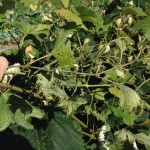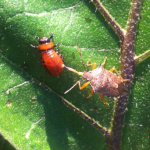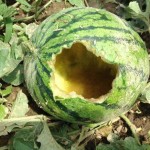Fruit:
Apples are progressing in fruit development and overall the crop looks very good. Codling moth numbers increased in several orchards this week, which will trigger a biofix date to determine treatment for second generation codling moth. Sooty blotch, one of our summer fungal diseases was noted on some apples this week. Growers need to stay on a fungicide program to prevent both sooty blotch and fly speck disease development during the summer. All apple maggot traps remained negative the week of July 20-24. Other insects noted at below threshold levels in orchards included green apple aphids, and Japanese beetles. European red mites and 2-spotted spider mites were found at threshold levels in a couple of orchard.
Peaches are developing with minimal pest issues being noted. Oriental fruit moth trap captures remained high this week about the 4th week in a row that captures were high. Both the peach tree borer and lesser peach tree borer moth showed up in trap captures in a couple of orchards the week of July 20-24. Growers will be advised to do some preventative treatment against borer damage. Growers are encouraged to maintain fungicide sprays to prevent brown rot and scab.
Spotted wing drosophila (SWD) were caught in traps at 3 different locations during the week of July 20-24. Some traps had multiple captures as SWD populations begin to build. Commercial small fruit growers should be spraying ripe fruit and fruit that is beginning to ripen to protect against SWD infestation. Rotate between chemical classes of approved insecticides.
Other than SWD, powdery mildew is showing up in grapes and growers need to be on a fungicide program to prevent damage from this disease. Black raspberry harvest has finished and red raspberries are being harvested, while blackberry harvest is beginning. Early variety blueberries are finished, while mid and late season berries are being harvested. Japanese beetles are present in low levels and birds are working on some of the berries.
Vegetables:
The sun came out and there were multiple days without rain this week, which is helpful in vegetable growth, fruit development and fruit ripening. Disease pressure remains high.
Stink bug damage is showing up more frequently in the scouting reports and growers need to be protecting fruit from stink bugs. Other insect pests noted the week of July 20-24 include the tomato hornworm and white flies. (See photo below)
The most serious disease problems in both field and high tunnel grown tomatoes remain septoria leaf spot and early blight. In warm, wet conditions, septoria can rapidly defoliate a plant if not managed early with an effective and consistent fungicide spray program. Scouts noted entire plantings and rows of tomatoes being lost to septoria and early blight in some fields. Scouts also found tomato fruit damaged by the early blight pathogen. Bacterial spot is also showing up, mainly in field tomatoes and growers are being advised to not work with the plants when they are wet, practice good sanitation between infected and non-infected plants and maintain a copper spray program to suppress the disease. In high tunnel production scouts are also finding fusarium crown rot, leaf mold, botrytis gray mold, timber rot and powdery mildew. Non-disease, environmental disorders that scouts are finding include yellow shoulder, catfacing and zippering. (See photo below)
Garlic and onion harvest is underway and scouts report that overall clove and bulb size is good.
Cole crops overall look good. Some of the new plantings for a planned fall harvest had imported cabbage worm numbers above treatment threshold and growers were advised to treat. Flea beetles were also noted on some of the new plantings, but not at economic treatment level. Established plantings are at the almost ready to harvest to harvest underway stage. Some bacterial soft rot was noted in some plants of one planting by scouts. Imported cabbage worm larvae were found and in some fields were at economic treatment threshold.
In vine crops, many plantings of summer squash and zucchini are being harvested regularly, fall squash and pumpkins are in bloom to some approaching harvest, cantaloupes are being harvested, watermelons range from fruit set to nearly harvest ready, and cucumbers range from new plantings to harvest. Downy mildew was found in more cucumber fields this past week. Scouts also found possible downy mildew in cantaloupe and sent a sample in to the vegetable pathology lab at OARDC for confirmation. Growers are being advised to use a fungicide spray program on a 5-7 day schedule to protect against downy mildew. Cucumbers are most vulnerable followed by cantaloupe and then squash, pumpkins and watermelon.
Probably the quickest developing disease across vine crops at this time is powdery mildew. Scouts noted in increase in powdery mildew across plantings of summer squash, zucchini, pumpkins, fall squash and melons.
Bacterial wilt is being found in some cucumbers. Cucumber beetles, the vector of the disease were noted at above threshold levels in younger cucumber, squash, zucchini, and pumpkin plantings and growers were being advised to treat to prevent bacterial wilt.
Angular leaf spot, a bacterial disease has been found across all vine crops and in many fields. Anthracnose and alternaria leaf spot have also been found and growers need to be on a good fungicide spray program. Phytophthora blight on squash fruit was found in one field.
Deer damage was noted by scouts in a number of fields and melon damage possibly caused by mice and raccoons was noted. (See photo below)
Many pepper plantings are at the harvest stage. In some plantings, bacterial spot is present. Scouts also noted some mosaic virus and possible cercospora leaf spot in some plants this week. Japanese beetles, zebra caterpillars, grasshoppers and European corn borers were all found at low levels in some fields. Eggplant is doing well but there are plants with verticillium wilt and anthracnose. Colorado potato beetles and flea beetles were noted at above threshold levels in some field this week. Japanese beetles and stink bugs are present in low numbers.
Green beans vary from newly emerging to harvest. Defoliation generally below threshold damage levels by grasshoppers, and Japanese beetles have been noted, although in some isoloated areas of some plantings defoliation by Japanese beetles is heavy. Other insect pests noted at below threshold levels include bean leaf beetles, tarnished plant bugs and stinkbugs.
Sweet corn, due to staggered plantings, ranges from newly emerging to harvest. Only 2 corn earworm moth was caught between traps at 4 locations this week. European corn borer moth captures ranged from 0 to 2 between 4 trap locations the week of July 20-24. Corn earworm moth captures were 0 in 4 trap locations. Feeding by snails, slugs, European corn borer larvae, Japanese beetles and fall armyworm was noted by scouts this week. Japanese beetles are feeding on corn silks. In addition to Northern corn leaf blight, corn rust was found by scouts this week.
Potatoes overall look good and some are being harvested. Colorado potato beetle is at threshold levels in some plantings and under control in others. Low numbers of potato leaf hoppers and flea beetle were noted. Early blight and septoria leaf spot are showing up in some plantings. The occasional plant with blackleg is also being noted by scouts.
Agronomic Field Crops:
Corn ranges in development from v-10 to R3. In some fields lower leaves are turning yellow due to nitrogen shortage as the plant mobilizes nitrogen from older leaves to use for younger leaf growth. Wet soils have caused nitrogen loss through both denitrification and leaching. Grey leaf spot in some fields and some varieties is at levels that may warrant a fungicide spray at stage V-T. Northern corn leaf blight is also being seen in some fields but at low levels, so far below what would be considered for a fungicide treatment. Japanese beetles and grasshoppers are all being noted at low levels in some fields. There were 6 western bean cutworm moths captured between 2 trap locations this past week. Deer damage is also being noted.
In low areas and poorly drained areas water is standing in some fields and soybean growth and development is suffering. Root rot has been noted. In other fields soybean growth looks good and soybeans are at pod development, R3-4. Scouts are noting brown spot on the lower leaves of most soybean fields. White mold is starting to show up in pockets but generally low levels. Leaf defoliators including bean leaf beetle, Japanese beetles, grasshoppers and slugs have all been noted on scouting reports. Scouts are sweeping fields for stink bugs as they reach the R3 stage of development. Stink bugs were found at very low levels the week of July 20-24. (See photo below)
Alfalfa is being monitored for potato leaf hoppers. Populations are still low at this time. Alfalfa height ranges from 5 to 17 inches. A variety of insects are being noted in sweep net samples including aphids, grasshoppers, Japanese beetles, alfalfa plant bugs and clover worms. All are at levels below an economic treatment threshold.








